Best Manta Ray Snorkeling in the World: Top 9 Locations
Seeking an unforgettable manta ray snorkeling experience? From coastal reef mantas to oceanic giants, here’s 9 of the world's top renowned locations for snorkeling with manta rays.
1. Hanifaru Bay, Maldives

Hanifaru Bay in the Maldives is a world famous UNESCO Biosphere protected marine area, renowned for its huge gatherings of manta rays. From May to November during the southwest monsoon season, plankton blooms draw in large numbers of mantas, providing exceptional snorkeling opportunities.
What sets Hanifaru Bay apart is the chance to snorkel among hundreds of manta rays and witness their unique 'cyclone feeding' behavior. Cyclone feeding occurs when a large group of mantas forms a tight, swirling circle to efficiently consume plankton.
Located within the Baa Atoll Biosphere Reserve, Hanifaru Bay is positioned along a deep-water channel that separates it from the neighboring island of Dharavandhoo. Access is typically arranged through local resorts or dive centers in nearby atolls, the closest resorts include Kihaa Maldives and Westin Maldives Miriandhoo Resort. Dive centers on Dharavandhoo are also well-positioned to provide the latest updates on manta ray activity, ensuring visitors are guided to the bay when sightings are optimal.
| Manta Species | Reef |
| Best Time | June to October |
2. Raja Ampat, Indonesia
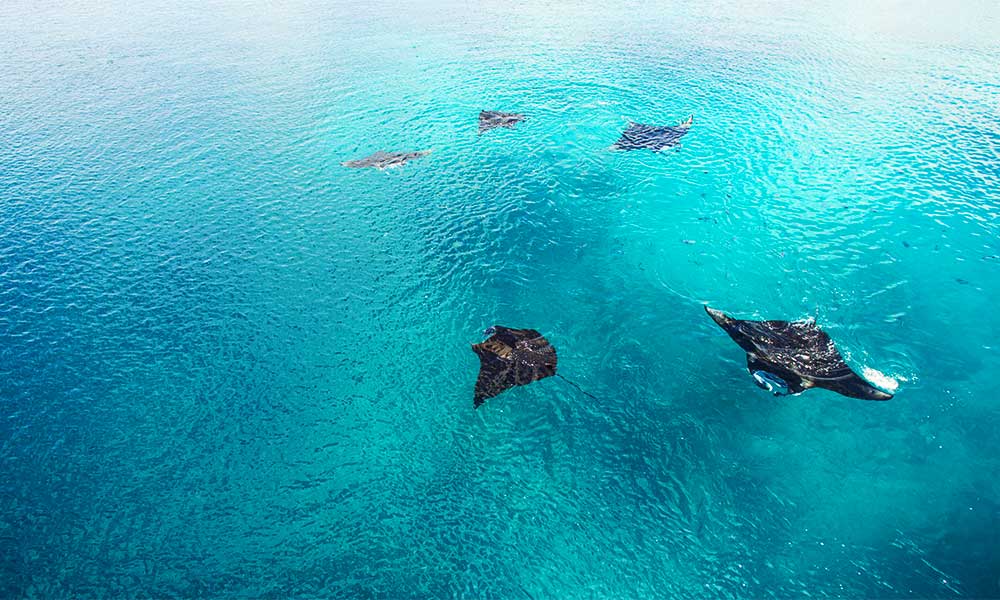
Raja Ampat, celebrated for its extraordinary marine life diversity, provides unique encounters with both oceanic and reef manta rays, especially across the Dampier Strait. Navigating these waters requires confidence and skill, as currents vary from calm to very strong.
Snorkel excursions can often be arranged with the many local homestay’s or dive resorts scattered across the central region of Raja Ampat.
Here are a few of the most sought-after sites where these majestic creatures can often be spotted:
Arborek Jetty
Arborek Jetty is a tiny Maldivian like island, known for its snorkel-friendly jetty surrounded by abundant marine life. Situated close to Manta Sandy and other cleaning stations, Arborek has frequent sightings of passing reef manta rays, commonly around the south-western side of the island.
Manta Sandy
Known for its manta ray cleaning stations, Manta Sandy is a relatively shallow site with a sandy bottom, popular for snorkeling due to its gentle currents and proximity to Arborek Island. Snorkeling here during the right season provides an amazing opportunity to observe mantas up close as they interact with cleaner fish. While reef mantas are the usual sightings, oceanic mantas are occasionally spotted here as well.
Manta Ridge
Named for its frequent manta ray sightings, Manta Ridge is a popular site to encounter both reef and oceanic rays in large groups. Located near Manta Sandy, the stronger currents here provide an exhilarating experience. While mainly explored by scuba divers, adventurous snorkelers can also enjoy watching mantas gracefully glide over the pristine coral ridge, as long as they avoid the occasional extreme conditions.
| Manta Species | Oceanic and Reef |
| Best Time | November to March |
3. Kona, Big Island Hawaii, USA
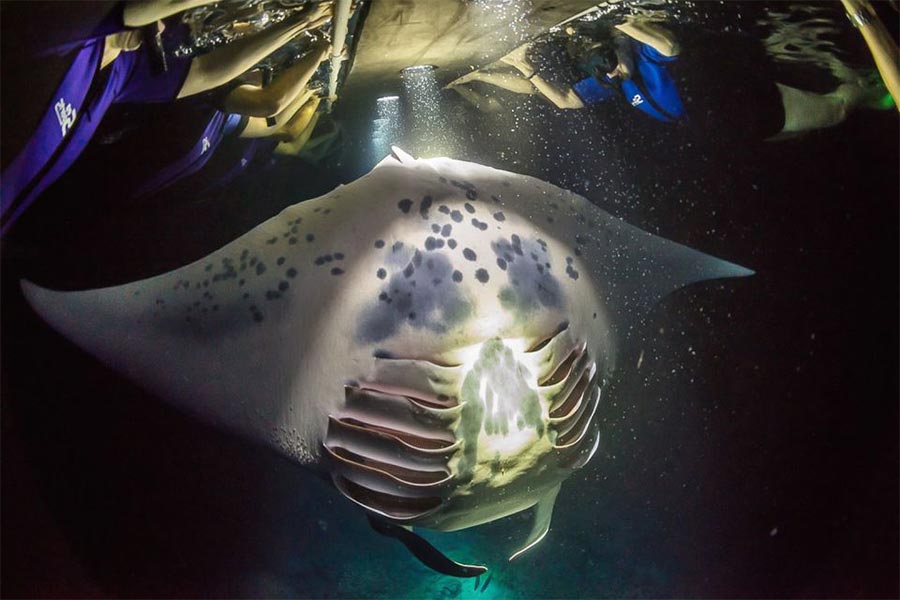
The Kona coast on the Big Island of Hawaii is world-famous for night snorkeling with manta rays, and offers a superb chance to see these magnificent creatures up close.
While manta rays here can be spotted at different times of the day, the optimal time for viewing them is at night when they gather in large numbers to feed on plankton attracted by underwater lights.
Although you can potentially snorkel with manta rays along the entire Kona Coast, most tour operators will take participants to specific sites like Manta Village or Manta Ray Heaven. These spots have the highest concentration of mantas in Hawaii, providing unforgettable nighttime snorkeling experiences where you can witness the mantas feeding in droves.
Manta ray sightings are less reliable on other Hawaiian islands compared to the Big Island. While snorkeling on Maui at Molokini or Olowalu, there is a very rare chance of encountering a manta ray. Snorkeling on Oahu and Kauai, the opportunities for seeing manta rays are even fewer and less likely. The Big Island, particularly around Kona, remains the best and most consistent location in Hawaii for encountering mantas.
Manta Village (Kaukalaelae Point)
Manta Village is situated in front of the Outrigger Kona Resort & Spa at Keauhou Bay, and it is renowned as the top spot for manta ray snorkeling on the island due to its consistently higher manta sightings. The area attracts mantas with floodlights that draw in a dense concentration of plankton, which is their primary food source. Over time, the mantas have become accustomed to this plankton-rich location, creating a reliable feeding site.
Manta Heaven
Manta Heaven, also known as Garden Eel Cove, is situated in Makako Bay, offshore from the Kona International Airport and south of Manta Village. Established in 1999, this site is less crowded than Manta Village due to its distance from Kona town. However, sightings here can be less consistent compared to Manta Village.
| Manta Species | Reef |
| Best Time | April to September |
4. Komodo National Park, Indonesia
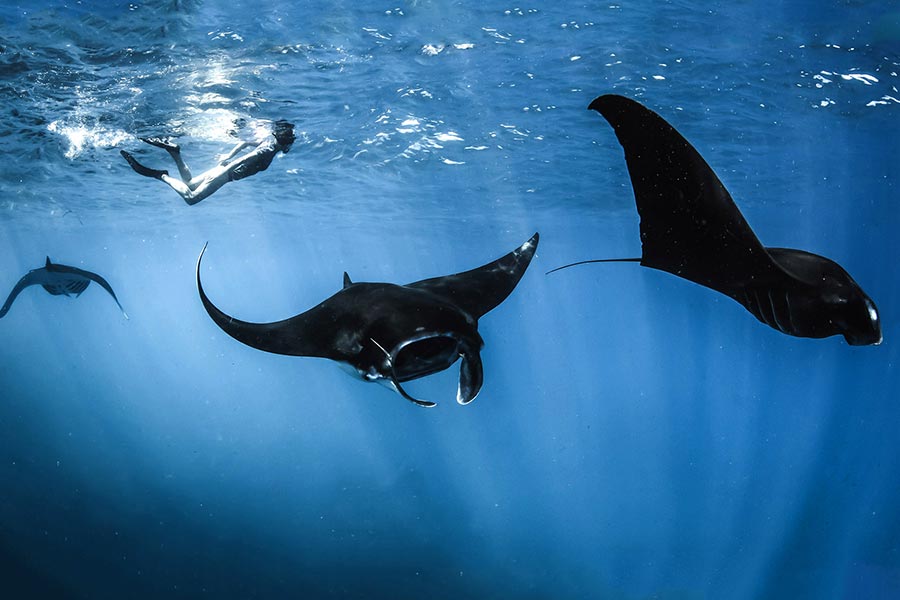
Komodo National Park is not only home to Komodo dragons but also world class snorkeling spots. Famously strong currents can be challenging for snorkelers, however, for those seeking encounters with manta rays, the rewards can be exceptionally high. Sites like Manta Point and Manta Alley are sublime for awesome interactions.
For safe snorkeling in these spots, it's essential to have a professional guide due to the strong currents. You can join a dive boat or snorkel tour, or alternatively hire an experienced guide and charter your own private snorkel boat.
Manta Point (Taka Makassar)
Taka Makassar, situated near Komodo and Rinca islands, boasts the longest reef in Komodo National Park. Adjacent to Taka Makassar is Manta Point, renowned as one of Indonesia's top manta ray sanctuaries year-round. Its abundance of mantas are attracted by strong currents and plankton-rich waters. At a depth of just ten meters, snorkelers can enjoy this underwater paradise, experiencing the beauty of the marine world without venturing deep.
Manta Alley (Karang Makassar)
Manta Alley, also called Karang Makassar, is another favored spot in Komodo National Park for snorkeling with manta rays. Similar to Manta Point, it features abundant mantas, healthy corals, and strong currents. The action primarily occurs in a shallow channel that is 5-10 meters wide and 20 meters long, where the "manta party" comes alive during strong currents. Lucky snorkelers may witness upwards of 30 mantas in this exhilarating underwater spectacle.
| Manta Species | Reef |
| Best Time | June to October |
5. Lady Elliot Island, Great Barrier Reef, Australia
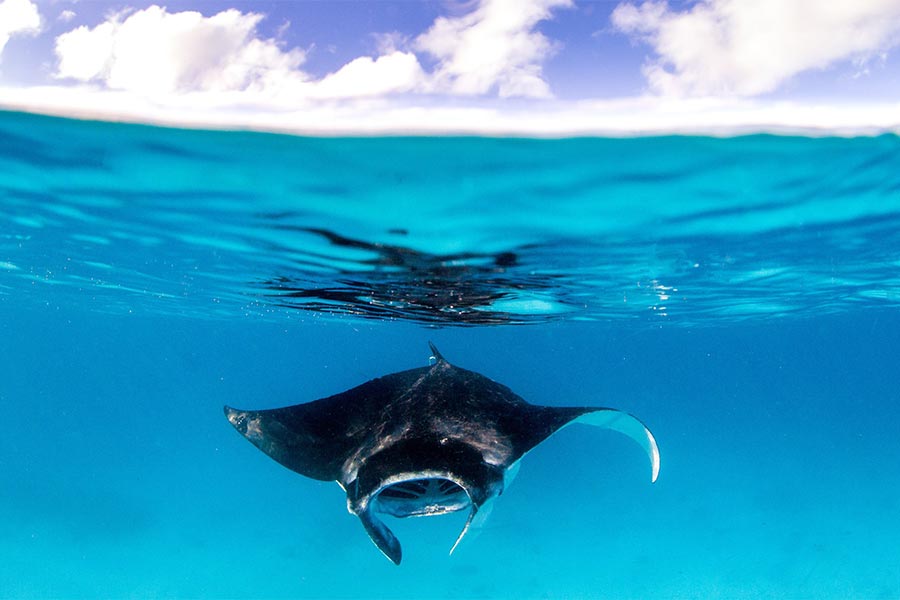
Lady Elliot Island, situated at the southernmost tip of the Great Barrier Reef, hosts one of Australia's largest annual Manta Ray gatherings, making it probably the best place in Australia to encounter these majestic creatures. Operated by the Lady Elliot Island Eco Resort and accessible solely by small aircraft, this secluded island spans just 42 hectares (100 acres), allowing visitors to walk around it in a mere 45 minutes.
The island's popularity necessitates booking well in advance, whether for a day trip or overnight stay, due to limited availability.
While guided tours typically facilitate snorkeling with manta rays, these awe-inspiring creatures can also be spotted during independent snorkeling from the beach.
Lady Elliot Island boasts two recommended snorkeling areas: the sheltered lagoon on its eastern fringe and the vibrant coral reef to the west, each offering distinct underwater experiences.
The Lagoon (eastern side)
The eastern side Lagoon provides a shallow and protected environment, making it perfect for beginners. Exploring this area while snorkeling reveals stunning coral formations and a vibrant array of marine life, including colorful tropical reef fish, octopus, sea stars, reef sharks, and sea turtles.
The Coral Reef (western side)
This area provides excellent opportunities to spot manta rays. The coral bommies host cleaning stations that attract mantas year-round, with larger numbers typically seen from May to September during the cooler months.
| Manta Species | Reef |
| Best Time | May to September |
6. Yap, Micronesia
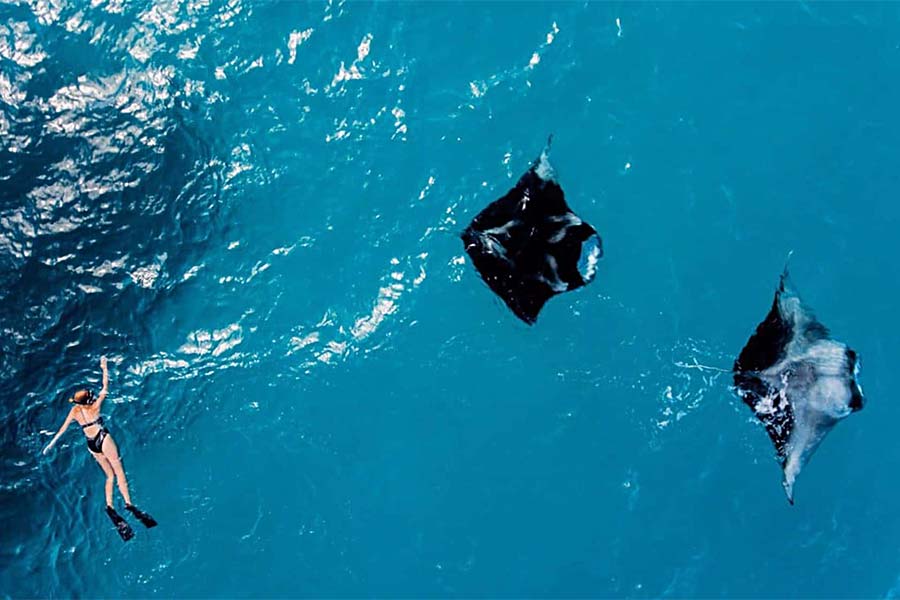
Yap, Micronesia, is a snorkeler's paradise and among the best places globally to encounter manta rays up close at cleaning stations. The island is also famous for its impressive underwater walls and healthy population of grey reef sharks.
Snorkelers can often join scuba diving excursions to reach manta cleaning stations. Many dive shops and resorts organize trips suitable for snorkelers. These trips are typically guided by experienced instructors who know the best locations and times for sightings. Private charters can also be aranged from local dive shops or resorts.
Manta Ridge (Mi’l Channel)
The prime location for consistently viewing large groups of mantas is Manta Ridge, situated on the northern end of the island at a depth of less than 30 feet (10 meters). This shallow coral ridge spans across Mi’l Channel, where strong tidal currents create an ideal cleaning station for mantas, often attracting up to thirty rays at once. Snorkelers can hold onto a rope attached to a boat anchored over the ridge, but due to the strong currents, this area is recommended for proficient swimmers and experienced snorkelers.
| Manta Species | Oceanic and Reef |
| Best Time | September to May |
7. Galápagos Islands, Ecuador
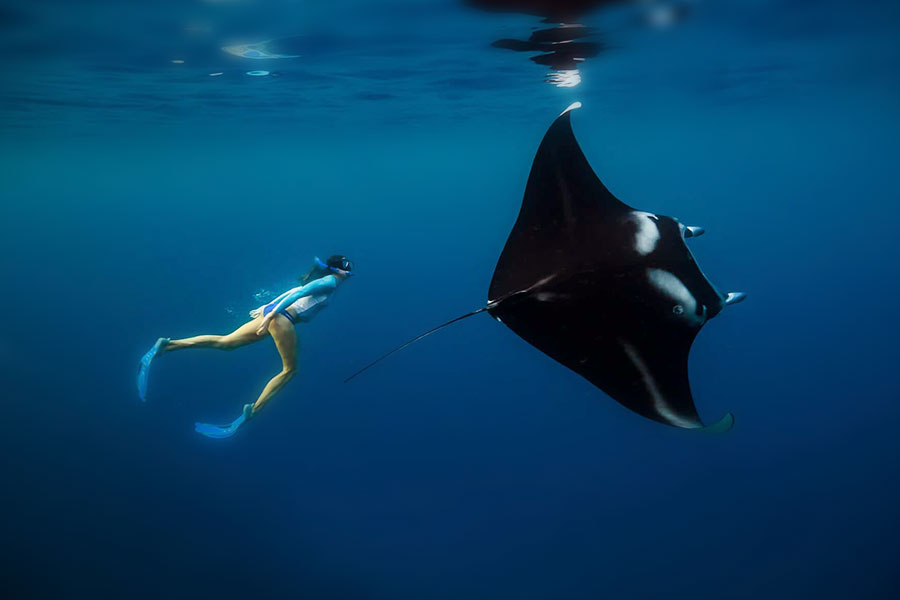
The Galapagos is one of the most dreamed about destinations for ocean lovers, offering a unique opportunity to encounter large pelagic fish such as hammerhead sharks, turtles, and many species of rays. Where else in the world can you experience all of this and snorkel alongside sea lions, penguins, and iguanas?
For the best experience exploring the diverse sites across the archipelago, a dedicated snorkeling liveaboard is likely the optimal choice. However, if you're looking to save money, staying on islands like Santa Cruz or Isabella and joining day trips can be a more budget-friendly alternative.
The ideal time for snorkeling in the Galápagos Islands, especially for manta ray sightings, is during the dry season from April to October, when the water is cooler and visibility is exceptional. Water temperatures during this season typically range from 20 to 30 degrees Celsius. It's highly recommended to wear a minimum 3mm thick snorkeling skin or wetsuit.
Santiago island and Sombero Chino islet
Sombrero Chino, or Chinese Hat Island, is a stunning small island situated off the southeast tip of Santiago Island. This picturesque spot boasts white coral beaches, a volcanic terrain, and is encircled by pristine, transparent waters.
The channel between Santiago and Sombrero Chino is perfect for observing manta rays. Key snorkeling locations nearby include Puerto Egas, Albany Islet, Piedra Blanca at Buccaneer Cove, Cousins Rocks, Bainbridge Rocks, Don Ferdi Rock, and Beagle Rocks.
Tortuga Island (Brattle Island)
Explore Tortuga Island for thrilling snorkeling near Isabela in the Galapagos. This small islet, shaped like a half-moon from an extinct volcano, is a hotspot for encountering hammerhead sharks and manta rays. Just a 45-minute speedboat ride from Puerto Villamil, this trip often includes land-based birdwatching and deep-sea fishing as well.
Gordon Rocks
Located near the east coast of Santa Cruz, this volcanic crater is renowned as one of the best snorkeling sites in the central Galapagos islands. Divers worldwide flock to Gordon Rocks for its exceptional sightings of hammerhead sharks, drawn by the strong currents that also attract majestic manta rays. It offers numerous excellent spots for experienced snorkelers comfortable with strong currents and surge.
| Manta Species | Oceanic and Reef |
| Best Time | April to October |
8. Nusa Penida, Bali, Indonesia
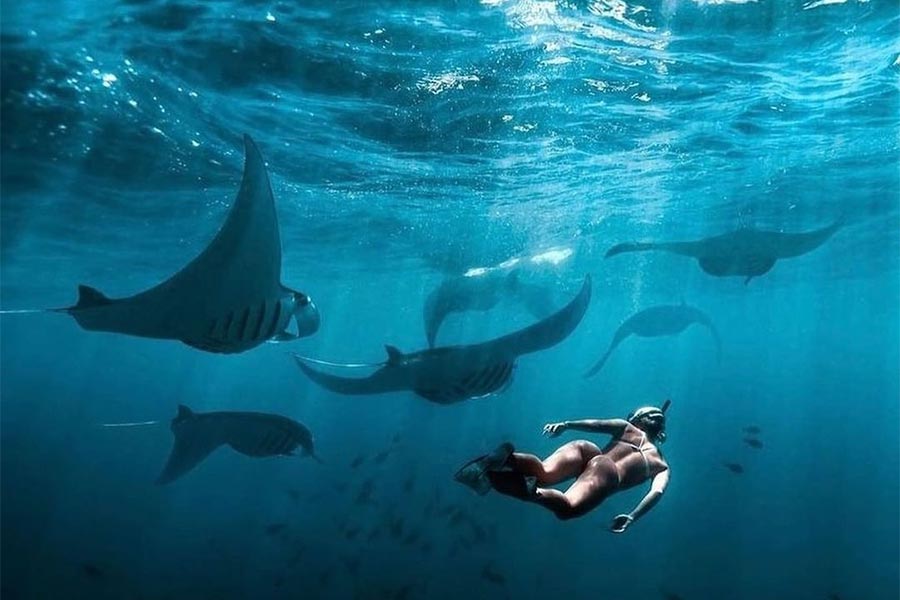
Nusa Penida, an island southeast of Bali, is renowned for its abundant reef manta ray sightings. Popular sites like Manta Point and Manta Bay along the Nusa Penida coast attract mantas throughout the year, offering exceptional opportunities to observe these majestic creatures in exceptionally clear waters.
Snorkeling tours to encounter mantas typically depart from Toyapakeh on Nusa Penida, neighboring Nusa Lembongan, or are arranged as day trips by speedboat from Sanur on mainland Bali.
While the coral reefs around Nusa Penida are well-maintained, the waters can be challenging, with some of Indonesia's strongest currents and temperatures ranging from 20°C to 26°C. It is advisable for confident swimmers only and to wear full-length wetsuits and good snorkel fins when exploring these waters.
Manta Bay
Manta Bay is a prime location for snorkeling tours. It is preferred by tour operators for its high chance of encountering mantas in larger groups and its close proximity to Toyapakeh on Nusa Penida, just a quick 20-minute boat ride away.
Located in shallow bays near Angel’s Billabong where mantas gather to feed on plankton. The mantas can often be seen near the surface, sometimes even from passing boats, despite there being a cleaning station at 13 meters deep. While the mantas here are smaller than those at Manta Point, they are more abundant.
Manta Point
Manta Point at Nusa Penida is Bali's most famous dive site for seeing manta rays. While your chances of spotting larger mantas are higher here compared to Manta Bay, they tend to swim at greater depths, making conditions more challenging for snorkeling.
The depth at Manta Point ranges from 0 to 30 meters (0-100 feet), but most of the manta action occurs within the first 1-12 meters (1-40 feet) beneath the surface. With an average visibility of 10-15 meters (30-50 feet), snorkelers can get a good view from above.
In addition to mantas, snorkelers at Manta Point often encounter other ray species such as marble rays, eagle rays, stingrays, and blue spotted stingrays.
| Manta Species | Reef |
| Best Time | April to October |
9. Fiji
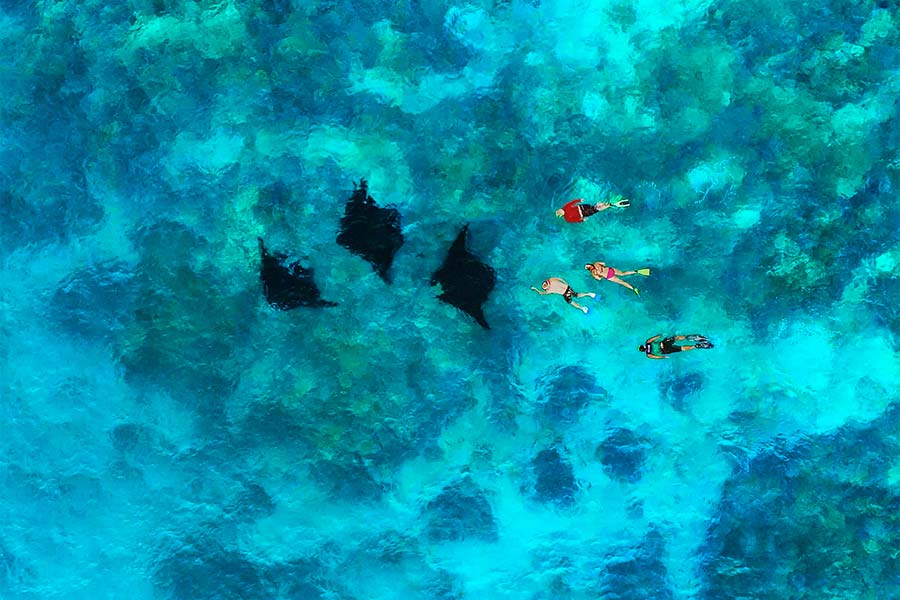
Fiji's warm and inviting waters offer unparalleled clarity, making it an exceptional destination for both novice and experienced snorkelers. This picturesque country is one of the few places in the world where snorkelers can reliably encounter manta rays. Known also as "The Soft Coral Capital of the World," Fiji boasts a diverse array of delicate soft coral species.
Manta ray sightings occur throughout the year, but the best chances of encountering them in Fiji are between May and October. During this period, nutrient-rich currents attract large numbers of manta rays to the region.
While easy-access shore snorkeling is ideal for beginners, the best snorkeling experiences can be found just a short boat ride away at the outer reefs.
Yasawa Islands (Manta Ray Passage)
Manta Ray Passage, located in the Yasawa Islands between Drawaqa and Naviti Islands, is a narrow channel known for daily visits from manta rays between May and October, particularly around tide changes. The reef manta rays that frequent this nearly 350-meter-wide passage can have wingspans ranging from 3 to 5 meters. They can be seen swimming alone or in groups of up to 4 or 5 individuals, both in the deeper areas and near the surface of the water.
Kadavu
In the remote Kadavu region of southern Fiji lies the Great Astrolabe Reef, home to several manta ray sites. Shallower spots, like those near Oneta Resort on Ono Island, are perfect for snorkeling. From Ono Island, a quick 10-minute boat ride takes you to the manta ray cleaning station, where local cleaner wrasse tend to these majestic creatures. As the use of regulators and oxygen tanks is prohibited in the area, Ono Island offers an exclusive snorkeling experience like no other.
| Manta Species | Reef |
| Best Time | May to October |
Top tips for snorkeling with manta rays
Follow these tips to get the most out of your experience with manta rays
Give space: Give the mantas space to move (3m or more is ideal). Touching, harassing or splashing about too much could scare them off so keep your movements slow and calm.
Follow your guide: There’s lots going on, so stick with your guide, if you have one, and be aware of your surroundings (boats snorkelers, divers) to avoid injury.
Be eco-friendly: Wear reef-safe sunscreen so you don’t burn on the boat ride back to your resort.
Be patient: Know that mantas are wild animals and don’t always stick to a schedule. If you stay in the area for a few days during the season, you’re more likely to meet with them.
Dry your ears: To prevent swimmer's ear (Otitis Externa), clean and dry your ears before and after each snorkel session with this DIY ear drop solution.
Gear Up for Manta Ray Encounters

When preparing for manta ray snorkeling, having the right gear can enhance your experience and ensure comfort and safety in the water. Here are some essential items and recommendations for good snorkel gear.
Don’t forget your underwater snorkeling camera! You don’t want to miss filming a fly by!





